As the U.S. celebrates $95.3 billion in military funding for Israel, Taiwan, Ukraine and itself, here’s a look at Washington’s Indo-Pacific strategy and what’s at stake.
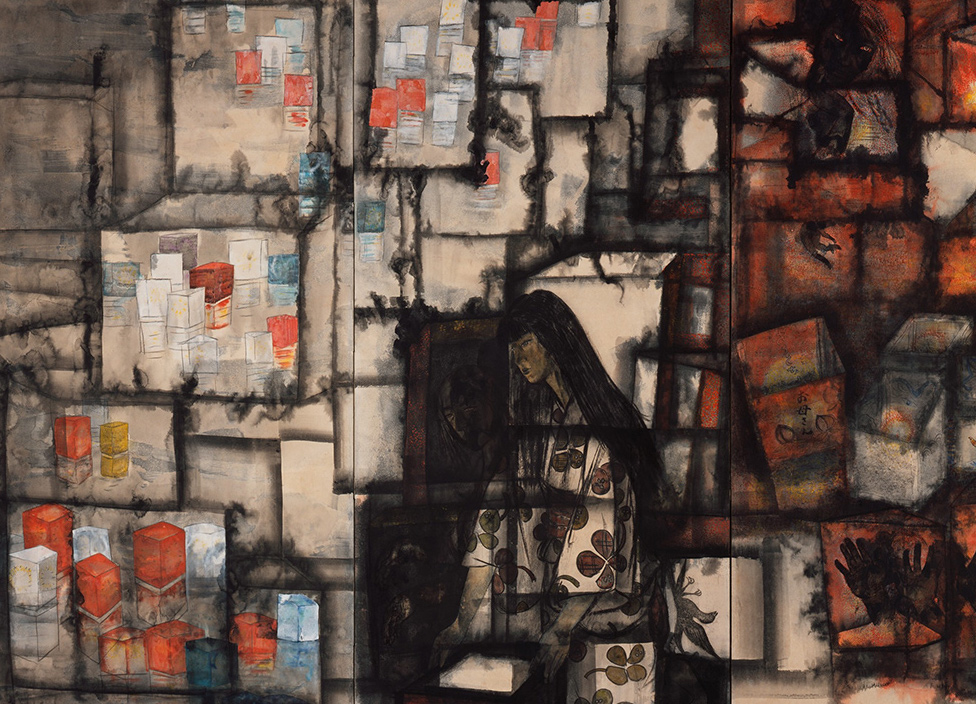
Iri and Toshi Maruki, “XII Floating Lanterns,” 1968, from The Hiroshima Panels.
(Via Tricontinental: Institute for Social Research)
By Vijay Prashad
Tricontinental: Institute for Social Research
 On the evening of May 14, U.S. Secretary of State Antony Blinken climbed onstage at Barman Dictat in Kyiv, Ukraine, to pick up an electric guitar and join the Ukrainian punk band 19.99. Ukrainians, he said, are “fighting not just for a free Ukraine, but for a free world.”
On the evening of May 14, U.S. Secretary of State Antony Blinken climbed onstage at Barman Dictat in Kyiv, Ukraine, to pick up an electric guitar and join the Ukrainian punk band 19.99. Ukrainians, he said, are “fighting not just for a free Ukraine, but for a free world.”
Blinken and 19.99 then played the chorus of Neil Young’s “Rockin’ in the Free World,” entirely ignoring the implications of its lyrics — much as Donald Trump, who, to Young’s irritation, used the chorus in his 2015–2016 presidential campaign.
In February 1989, the day after Young received the news that his band’s tour in the U.S.S.R. fell through, he penned the song’s lyrics, resting on his criticisms of the Reagan years and the first month of George H. W. Bush’s presidency. While it sounds patriotic on the surface, that song — like Bruce Springsteen’s “Born in the USA” (1984) — is deeply critical of the hierarchies and humiliations of capitalist society.
The three verses of “Rockin’ in the Free World” paint a picture of despair (“people shufflin’ their feet/ people sleepin’ in their shoes”) defined by the drug epidemic plaguing the poor (a woman “puts the kid away/ and she’s gone to get a hit”), the collapse of educational opportunities (“there’s one more kid/ that will never go to school”), and a growing population that lives on the street (“we got a thousand points of light/ for the homeless man”).
Springsteen’s song, written in the shadow of the U.S. war on Vietnam (“so they put a rifle in my hand/ sent me off to a foreign land/ to go and kill the yellow man”), also captured the strangulation of the working class in the U.S., many of whom were unable to get a job after returning from a war they did not want (“down in the shadow of the penitentiary/ out by the gas fires of the refinery/ I’m 10 years burning down the road/ nowhere to run ain’t got nowhere to go”).
These are songs of anguish, not anthems of war. To chant “born in the USA” or “keep on rockin in the free world” does not evoke a sense of pride in the Global North but a fierce criticism of its ruthless wars. “Keep on rockin’ in the free world” is pickled in irony.
Blinken did not get it, nor did Trump. They want the allure of rock and roll, but not the acidity of its lyrics. They do not understand that Neil Young’s 1989 song is the soundtrack of the resistance to the U.S. wars that followed against Panama (1989–1999), Iraq (1990–1991), Yugoslavia (1999), Afghanistan (2001–2021), Iraq (2003–2011) and many more.
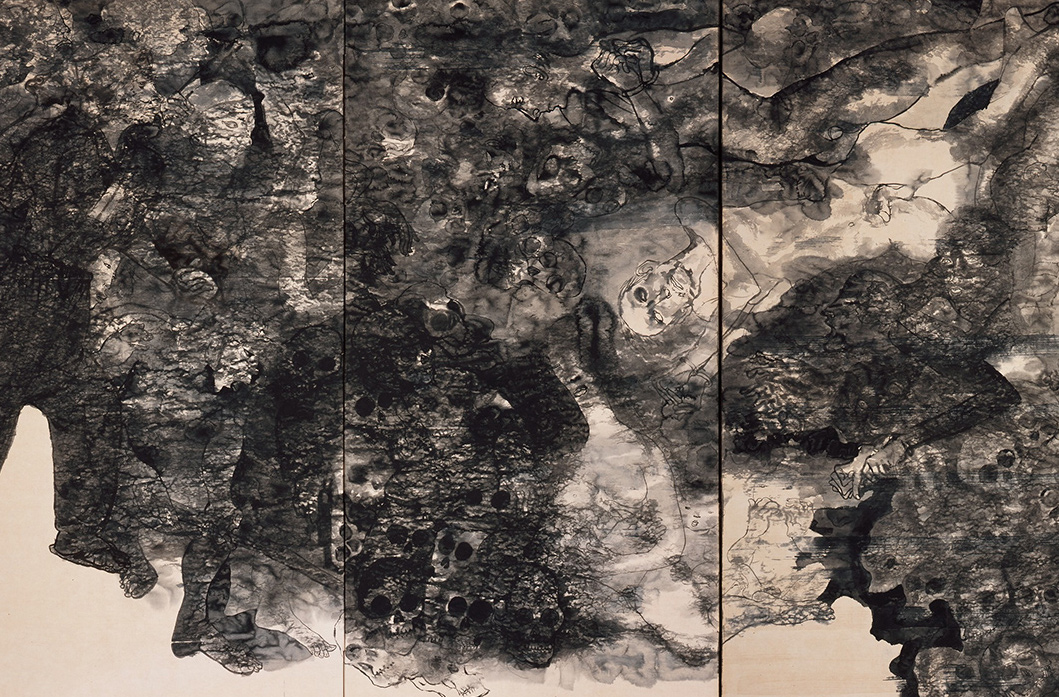
Iri and Toshi Maruki, “XIII Death of the American Prisoners of War,” 1971, from The Hiroshima Panels. (Via Tricontinental: Institute for Social Research)
Blinken went to Kiev to celebrate the passing of three bills in the U.S. House of Representatives that appropriate $95.3 billion for the militaries of Israel, Taiwan, Ukraine and the United States. This is in addition to the more than $1.5 trillion that the U.S. spends on its military every year.
It is obscene that the U.S. continues to supply Israel with deadly munitions for its genocide against Palestinians in Gaza, including the $26.4 billion it promised to Israel in the new bills while feigning concern for the starvation and slaughter of Palestinians.
It is ghastly that the U.S. continues to prevent peace talks between Ukraine and Russia while funding the former’s demoralised military (including $60.8 billion for weapons in the new bills alone) as the U.S. seeks to use the conflict to “see Russia weakened.”
At the other end of Eurasia, the U.S. has, similarly, used the issue of Taiwan in its efforts to see China “weakened.” That is why this supplemental appropriation allots $8.1 billion for “Indo-Pacific security,” including $3.9 billion in armaments for Taiwan and $3.3 billion for submarine construction in the U.S.
Taiwan is not alone as a potential frontline state in this pressure campaign against China: the newly formed Squad, made up of Australia, Japan, the Philippines, and the U.S., uses solvable conflicts between the Philippines and China as opportunities to weaponise dangerous manoeuvres with the hope of provoking a reaction from China that would give the U.S. an excuse to attack it.

Iri and Toshi Maruki, “XIV Crows,” 1972, from The Hiroshima Panels. (Via Tricontinental: Institute for Social Research)
Tricontinental’s new dossier, “The New Cold War is Sending Tremors Through Northeast Asia,” published in collaboration with the International Strategy Centre (Seoul, South Korea) and No Cold War, argues that “the U.S.-led New Cold War against China is destabilising Northeast Asia along the region’s historic fault lines as part of a broader militarisation campaign that extends from Japan and South Korea, through the Taiwan Strait and the Philippines, all the way to Australia and the Pacific Islands.”
The bogeyman for this build-up in what the U.S. calls the “Indo-Pacific” (a term developed to draw India into the alliance to encircle China) is North Korea, whose nuclear and missile programmes are used to justify asymmetrical mobilisation along the Pacific edge of Asia.
That South Korea’s military budget in 2023 ($47.9 billion) was more than twice North Korea’s GDP($20.6 billion) in the same year is just one example that highlights this imbalance. This use of North Korea, the dossier argues, “has always been a fig leaf for U.S. containment strategies — first against the Soviet Union and today against China.” (You can read the dossier in Korean here).
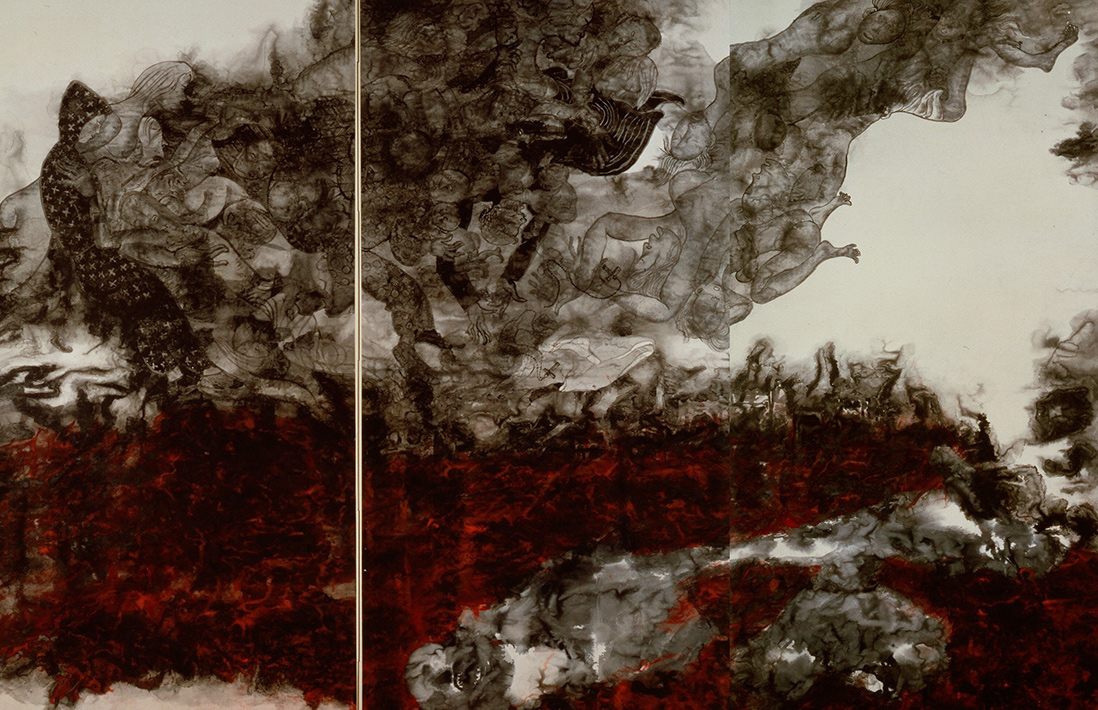
Iri and Toshi Maruki, XV Nagasaki, 1982, from The Hiroshima Panels. (Via Tricontinental: Institute for Social Research)
In the early years of the U.S. development of the “Indo-Pacific strategy,” Chinese scholars such as Hu Bo, Chen Jimin and Feng Zhennan argued that the term was merely conceptual, limited by the contradictions between the countries involved in the development of the Chinese containment strategy.
Over the past few years, however, a new view has developed that these shifts in the Pacific pose a serious threat to China and that the Chinese must respond with bluntness to prevent any provocation.
It is this situation, characterised by the U.S.’ creation of alliances that are designed to threaten China (the Quad, AUKUS, JAKUS and the Squad) alongside China’s refusal to bend before the hyper-imperialism of the Global North, that creates a serious threat in Asia.
The last section of the dossier, “A Path to Peace in Northeast Asia,” offers a window into the hopes of the people’s movements in Okinawa (Japan), the Korean peninsula and China to find a pathway to peace.
Five simple principles anchor this path: end the dangerous alliances, U.S.-led war games in the region and U.S. intervention into the region and support unity across struggles in the region as well as frontline struggles to end militarisation in Asia.
The latter point is being fought on several fronts by those living near Okinawa’s Kadena Air Base and Henoko Bay as well as South Korea’s Terminal High Altitude Area Defence installation and Jeju Naval Base, to name a few.
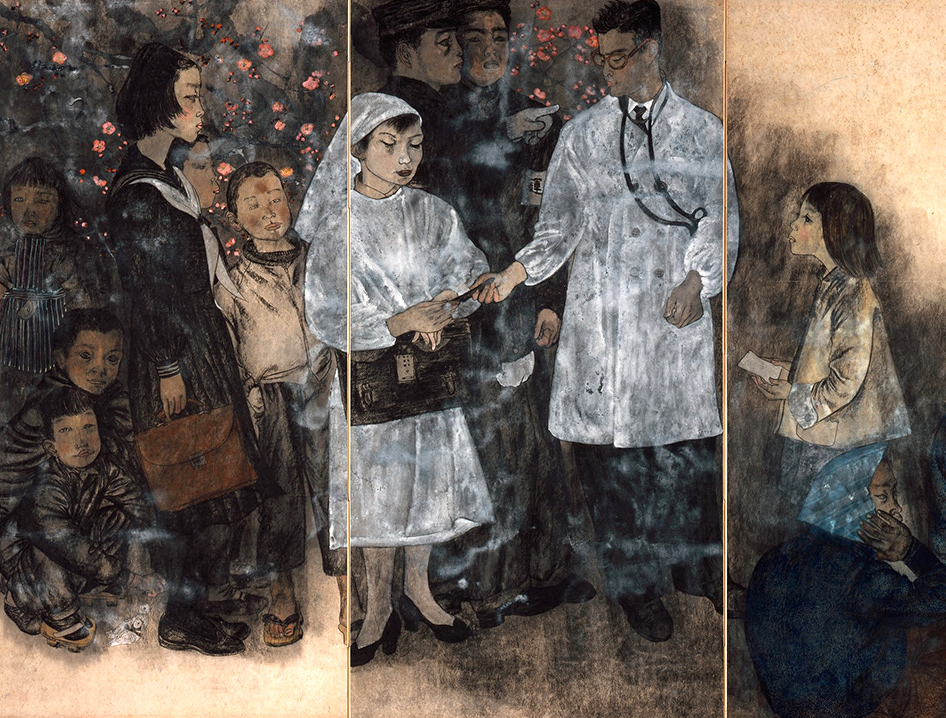
Iri and Toshi Maruki, “X Petition,” 1955, from The Hiroshima Panels. (Via Tricontinental: Institute for Social Research)
Several years ago, I visited the Maruki Gallery outside Higashi-Matsuyama city in Saitama, where I saw the remarkable murals made by Ira Maruki (1901–1995) and Toshi Maruki (1912–2000) to remember the terrible violence of the nuclear bombs that the U.S. government dropped on Hiroshima and Nagasaki.
These murals, in the traditional Japanese ink-wash style sumi-e, depict the immense human toll of the ugliness of modern warfare. Thanks to the chief curator Yukinori Okamura and the international coordinator Yumi Iwasaki, we were able to include some of these murals in our dossier and in this newsletter.
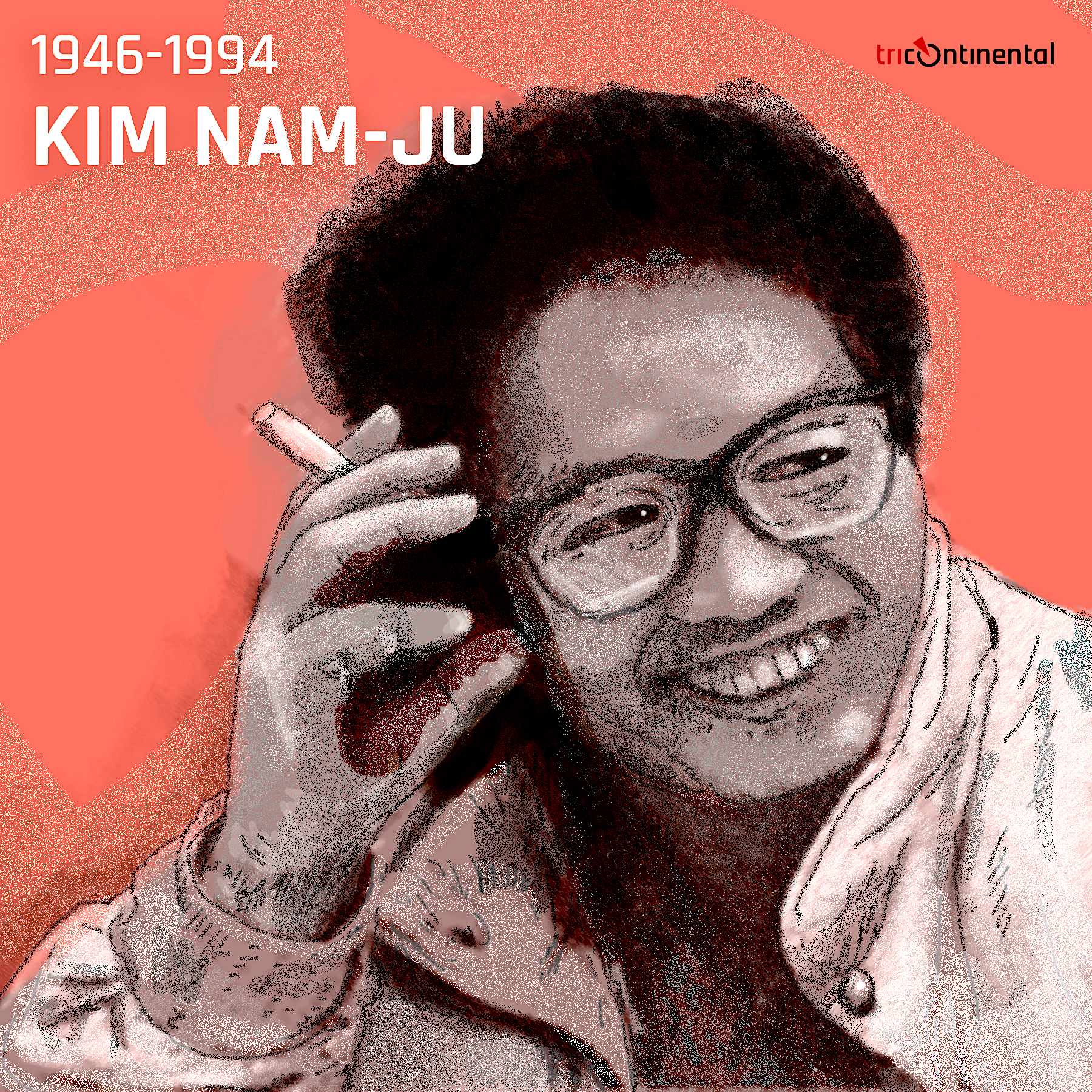
In 1980, the South Korean military dictatorship arrested Kim Nam-ju (1945–1994) and 35 other leftists on the grounds that they were involved in the National Liberation Front Preparation Committee. Kim was a poet and a translator who brought Frantz Fanon’s Black Skin, White Masks and Ho Chi Minh’s writings into Korean.
While in Gwangju Prison for eight years, Kim wrote a range of powerful poetry, which he was able to smuggle out for publication. One of those poems, “Things Have Really Changed,” is about the suffocation of the ambitions of the Korean people over their own peninsula.
Under Japanese imperialism, if Joseon people
shouted ‘Long Live Independence!’,
Japanese policemen came and took them away,
Japanese prosecutors interrogated them,
Japanese judges put them on trial.
Japan withdrew and the U.S. stepped in.
Now if Koreans
say ‘Yankee Go Home’,
Korean police come and take them away,
Korean prosecutors interrogate them,
Korean judges put them on trial.
Things have really changed after liberation.
Because I shouted ‘Drive out the foreign invaders!’,
people from my own country
arrested me, interrogated me, and put me on trial.
Vijay Prashad is an Indian historian, editor and journalist. He is a writing fellow and chief correspondent at Globetrotter. He is an editor of LeftWord Books and the director of Tricontinental: Institute for Social Research. He is a senior non-resident fellow at Chongyang Institute for Financial Studies, Renmin University of China. He has written more than 20 books, including The Darker Nations and The Poorer Nations. His latest books are Struggle Makes Us Human: Learning from Movements for Socialism and, with Noam Chomsky, The Withdrawal: Iraq, Libya, Afghanistan and the Fragility of U.S. Power.
This article is from Tricontinental: Institute for Social Research.
Views expressed in this article may or may not reflect those of Consortium News.
Please Donate to the
Spring Fund Drive!



Thank You Vijay
I’ve been to atomic bomb museums in Japan. They tell you about things you would rather not know.
A request to pundits—-
More than with most US adventurism, I have trouble working out just what US grandstanding in the Asian Pacific is intended to accomplish. We cannot hope for a clear and accurate confession from Joe Biden and Company, and I do not see a legitimate goal.
There is the chip industry in Taiwan, of course. But as things stand, this remains accessible to the West. Conversely, either the West or China could destroy it in an afternoon were military motive sufficiently intense. The US is not going to take over that industry and run it. If there is any idea about duplicating it, this would work better in Kansas or Carolina. But as things stand, the key knowledge that is passed along in American universities largely passes between Chinese nationals. Nothing in the military approach addresses the actual logistics or problems.
Applications of military principle change from generation to generation, but does anybody seriously want a land war in East Asia? If so, for what stakes? What is the payoff? Does the US wish to start farming rice and fish? Does it wish to retake the industry that it exported? Does it wish to take over water-generated electricity?
None of this makes sense, really. At the same time, there is this notion of “sanctions” for one thing or another. Usually these are heralded as enforcement of one or another ethical notion, but in practice they respond to concerns that other countries are trading between themselves. If one country seizes assets when one uses its currency, with which country must one stop trade?
Rulers in Washington have long tolerated being called idiots, knowing as they must that other accusations could be levied that might be consequential. Some sort of “grand chessboard” notionry must exist, but this no longer involves so much the idea that a nation should succeed, let alone an alliance of nations.
Who, then, and how?
America…the BIGGEST SHIT DISTURBER of modern times.